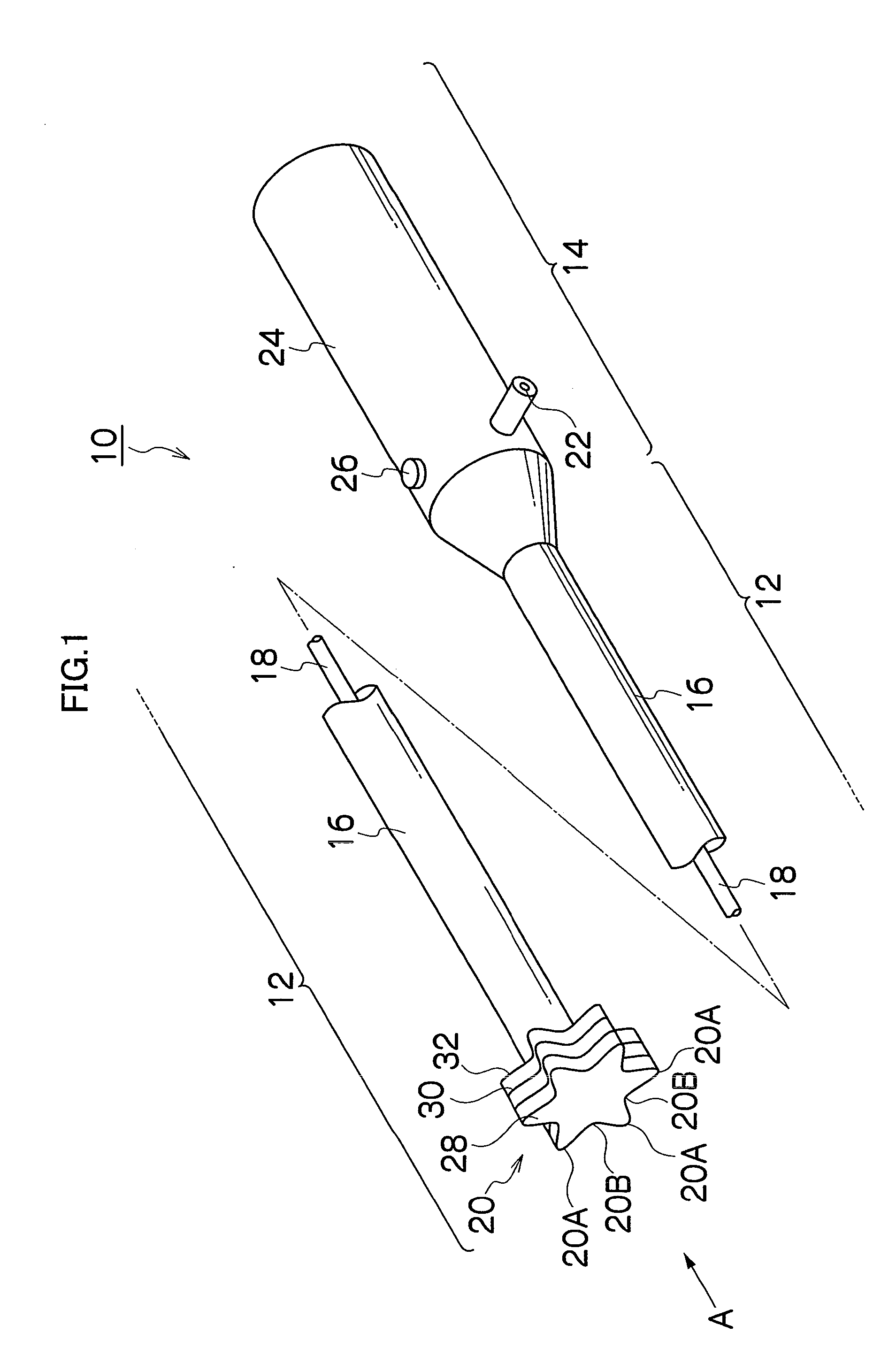Treatment instrument for endoscope
a treatment instrument and endoscope technology, applied in the direction of surgical staples, catheters, osteosynthesis devices, etc., can solve the problems of long treatment time and huge technical difficulties
- Summary
- Abstract
- Description
- Claims
- Application Information
AI Technical Summary
Benefits of technology
Problems solved by technology
Method used
Image
Examples
first embodiment
[0061]FIG. 1 is a perspective view showing a treatment instrument for endoscope 10. The treatment instrument for endoscope 10 generally includes, as shown in FIG. 1, an insertion section 12 which is inserted into a body, and a hand-side operation section 14 connected to the insertion section 12, and the insertion section 12 is configured with a non-conductive and flexible sheath 16, a conductive wire 18 which is inserted into the sheath 16, and a treatment section 20 mounted to a distal end of the flexible sheath 16. The distal end of the wire 18 is connected to the treatment section 20, and the proximal end of the wire 18 is connected to a connector 22 of the hand-side operation section 14. The connector 22 is electrically connected to a high-frequency current supply apparatus (not shown) for supplying a high frequency current. The hand-side operation section 14 has a grasping portion 24 with an operation button 26, so that a press-down of the operation button 26 causes a high freq...
second embodiment
[0084]FIG. 7 is a side view showing the distal end portion of a treatment instrument for endoscope of a second embodiment, FIG. 8 is a side cross sectional view showing the cross section of FIG. 7, FIG. 9 is a side view showing the treatment section of FIG. 7 in another posture, and FIG. 10 is a view of the treatment section of FIG. 9 seen in the direction B.
[0085]As shown in these figures, in the second embodiment, the treatment section 20 has a proximal end surface 20C from which a pair of bearings 42, 42 are protruded, and the bearings 42, 42 support a shaft 44. To the shaft 44, a first sleeve 46 is rotatably coupled at the distal end portion thereof, and to the proximal end portion of the first sleeve 46, a second sleeve 48 is engaged at the distal end portion thereof. The first sleeve 46 and the second sleeve 48 are coaxially arranged and coupled with each other, and also are coupled to relatively rotate about the central axes of the sleeves. To the proximal end of the second s...
third embodiment
[0101]The third embodiment is a bipolar-type treatment instrument performing a coagulation process only on the tissues between the electrodes (between the conductors), which enables a control to narrow the tissue area for coagulation. Therefore, the tissue area which may be damaged is narrowed, and the tissue damage caused by coagulation can be minimized.
[0102]In the above described third embodiment, both of the distal end side (the proper muscular layer 36 side) and proximal end side (the mucous membrane 34 side) of a cutting is processed for coagulation, but the positions for coagulation are not limited to those, and for example, a high frequency current for coagulation may be applied to the part between the conductors 91 and 94 so as to coagulate the entire area. Alternatively, a high frequency current for coagulation may be applied only to the conductors 91 and 92, so as to coagulate only the distal end side of the incision position.
[0103]Also, in the above described third embod...
PUM
 Login to View More
Login to View More Abstract
Description
Claims
Application Information
 Login to View More
Login to View More - R&D
- Intellectual Property
- Life Sciences
- Materials
- Tech Scout
- Unparalleled Data Quality
- Higher Quality Content
- 60% Fewer Hallucinations
Browse by: Latest US Patents, China's latest patents, Technical Efficacy Thesaurus, Application Domain, Technology Topic, Popular Technical Reports.
© 2025 PatSnap. All rights reserved.Legal|Privacy policy|Modern Slavery Act Transparency Statement|Sitemap|About US| Contact US: help@patsnap.com



